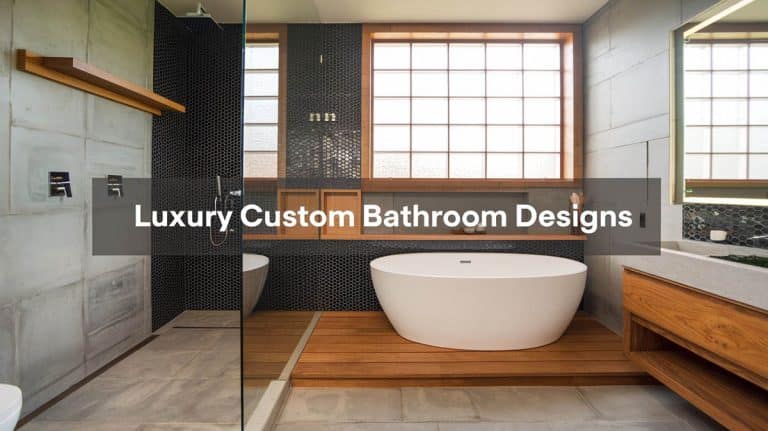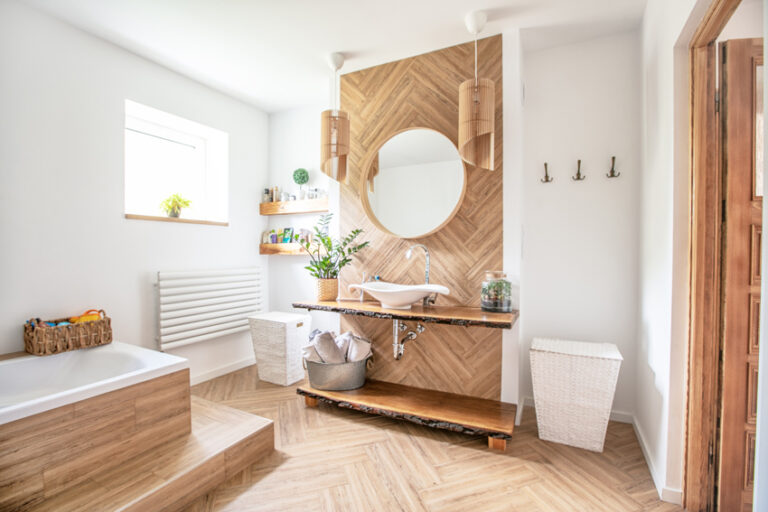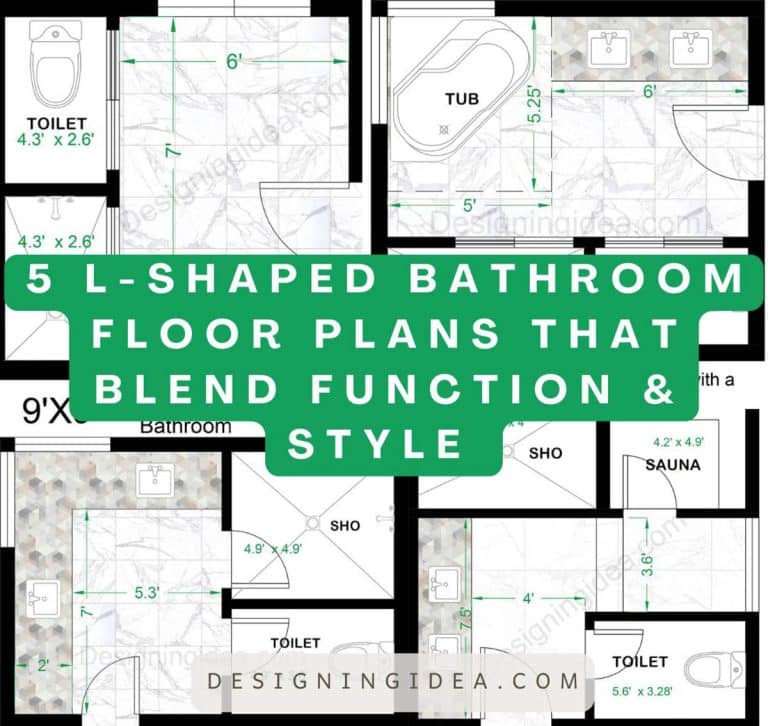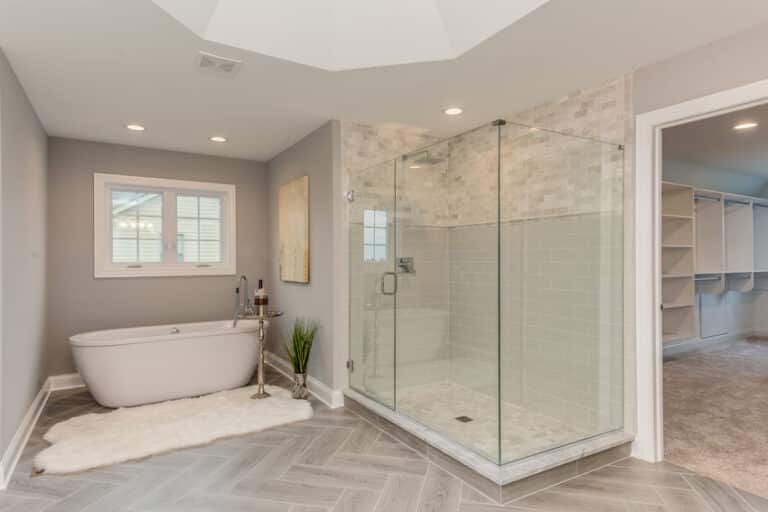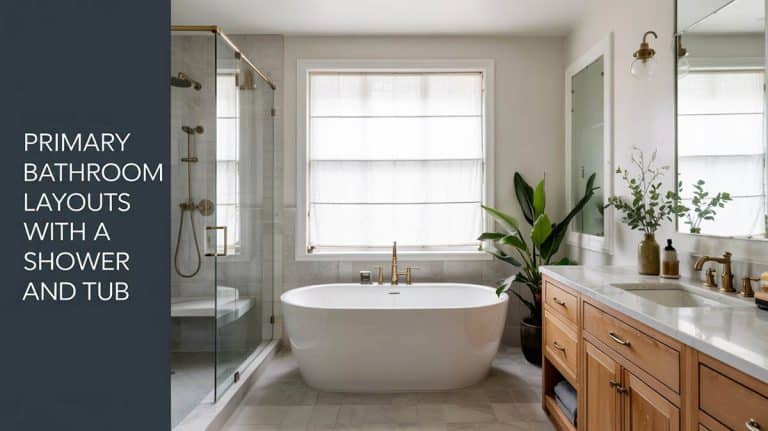Bathroom Remodel Ideas On A Budget
Applying bathroom remodel ideas on a budget will not only liven up the look of this space, but it can significantly improve your living conditions as well. This may be adding safety features, providing a more comfortable design, or setting up a livelier mood. However, bathroom remodeling can be costly, but there are ways to liven up your design while saving more on remodeling costs.
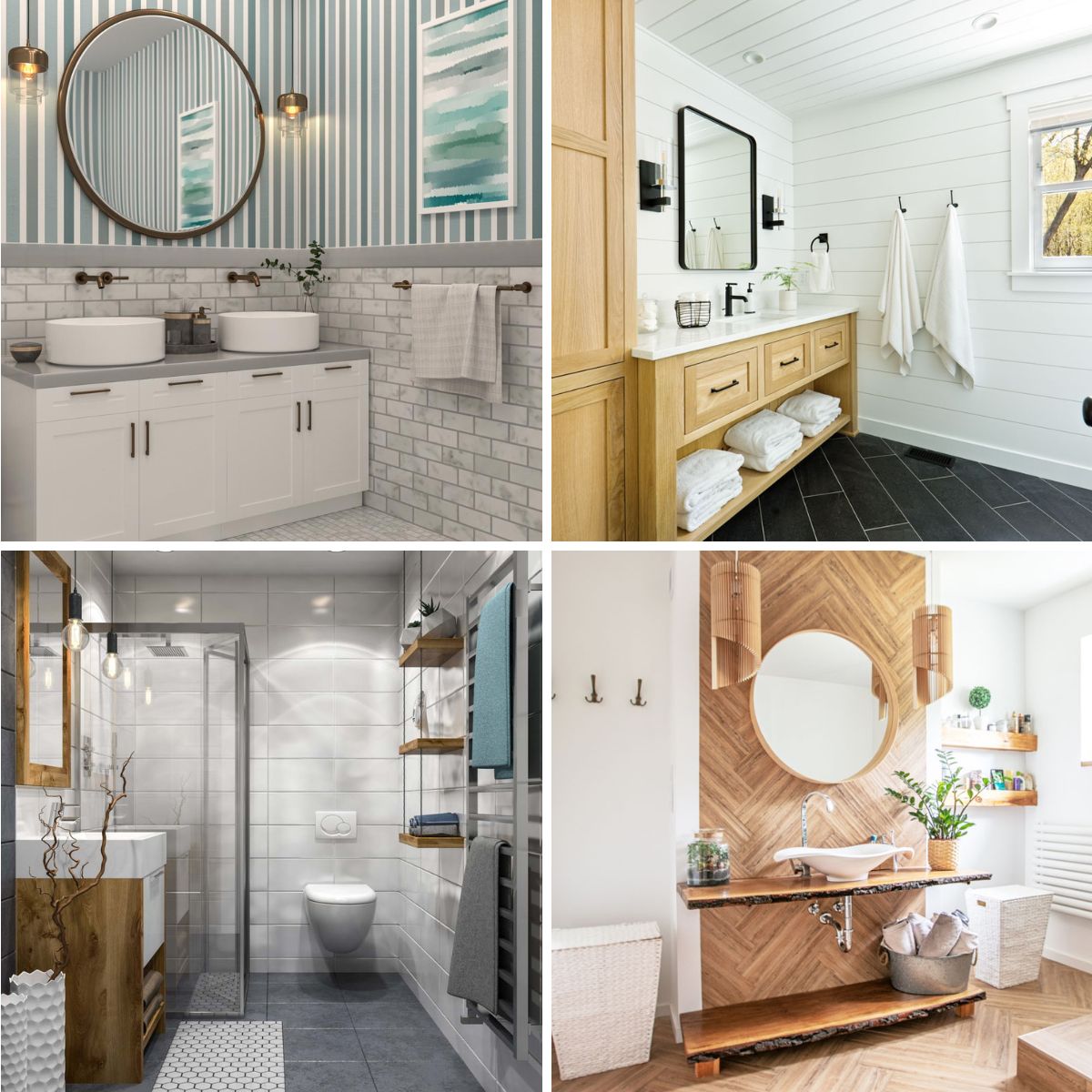
The following are bathroom remodeling ideas on a budget.
Planning your Bathroom Remodel
Define your needs and wants: Know your priorities, goals, and wants. You can narrow it down by making a list and categorizing each according to its importance, etc. By determining your needs and wants, you can get an overview of your construction project’s possible activities and an estimated timeframe. An unplanned scope of work can delay main works as well as create odd jobs that will accumulate and cost more than your average bathroom remodeling cost.
Provide clear goals and instructions to your contractor or designer: When hiring a professional, it is best to set clear goals and instructions to minimize waste and properly allocate resources properly. This also prevents misunderstandings between you and the contractor.
Set a Realistic Budget: How much are you willing to spend? Set up a budget and determine your needs and wants to go together. Prioritize and compromise according to the available sources you have. The funds will greatly define your work scope and guide you in allotting your budget. This also gives you an overview of how much work is needed. You do need to consider other expenses, such as permits, contractor’s fees, etc., for major bathroom remodel ideas.
Measure Your Space: Know the square footage of your floor plan. Through this, you can get a ballpark figure of the remodeling cost. Architectural Digest lists the average bathroom remodeling cost at $600 to $800 per square foot. However, every state or country has a different cost per square foot or meter. Thus, the larger the size, the more costly.
Select Your Materials: The cheapest countertop materials are ceramic and porcelain, where ceramic bathroom countertops can range from $2 to $20 per square foot, while porcelain countertops usually cost from $4 to $30 per square foot.
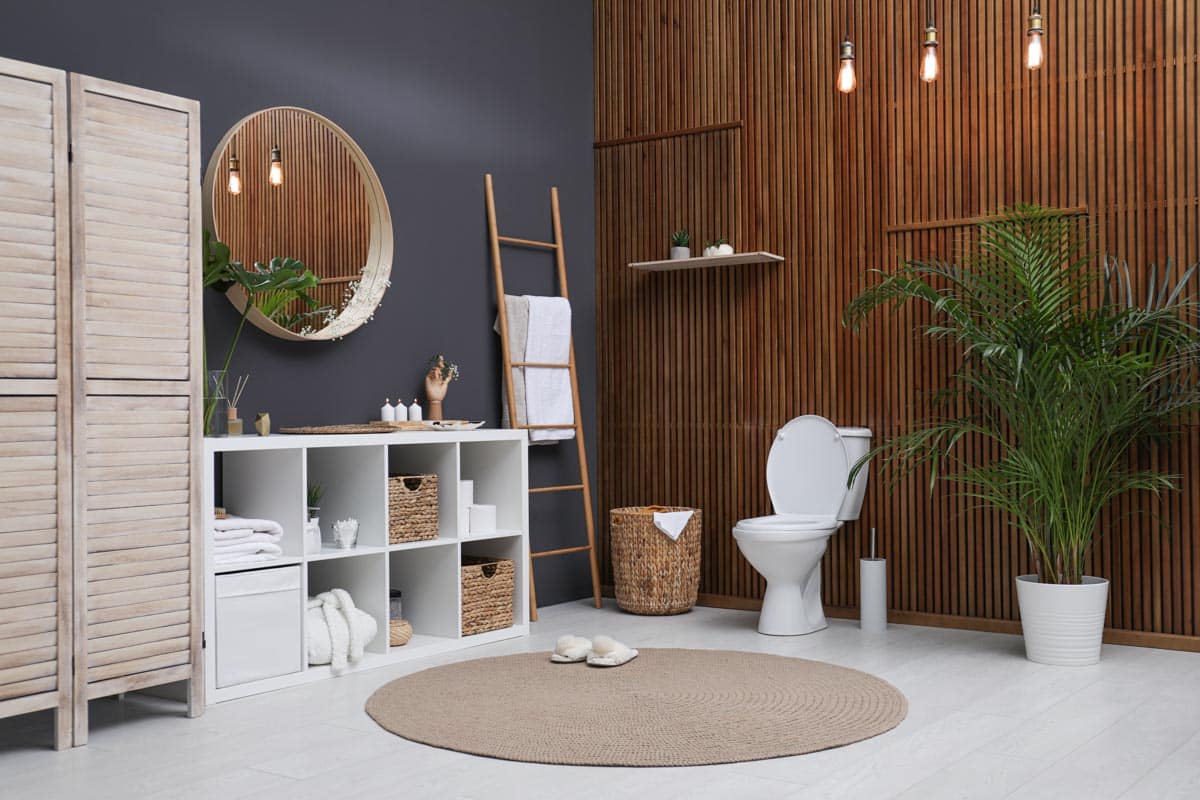
Aside from materials, there is also the choice between custom or prefabricated cabinets, countertops, or vanities, where premade furniture is usually more affordable than their customized versions.
There are many benefits to bathroom remodeling. NAR, or the National Association of Realtors, stated that there is a return on investment of about 71% for remodeling bathrooms.
Cost-Saving Strategies
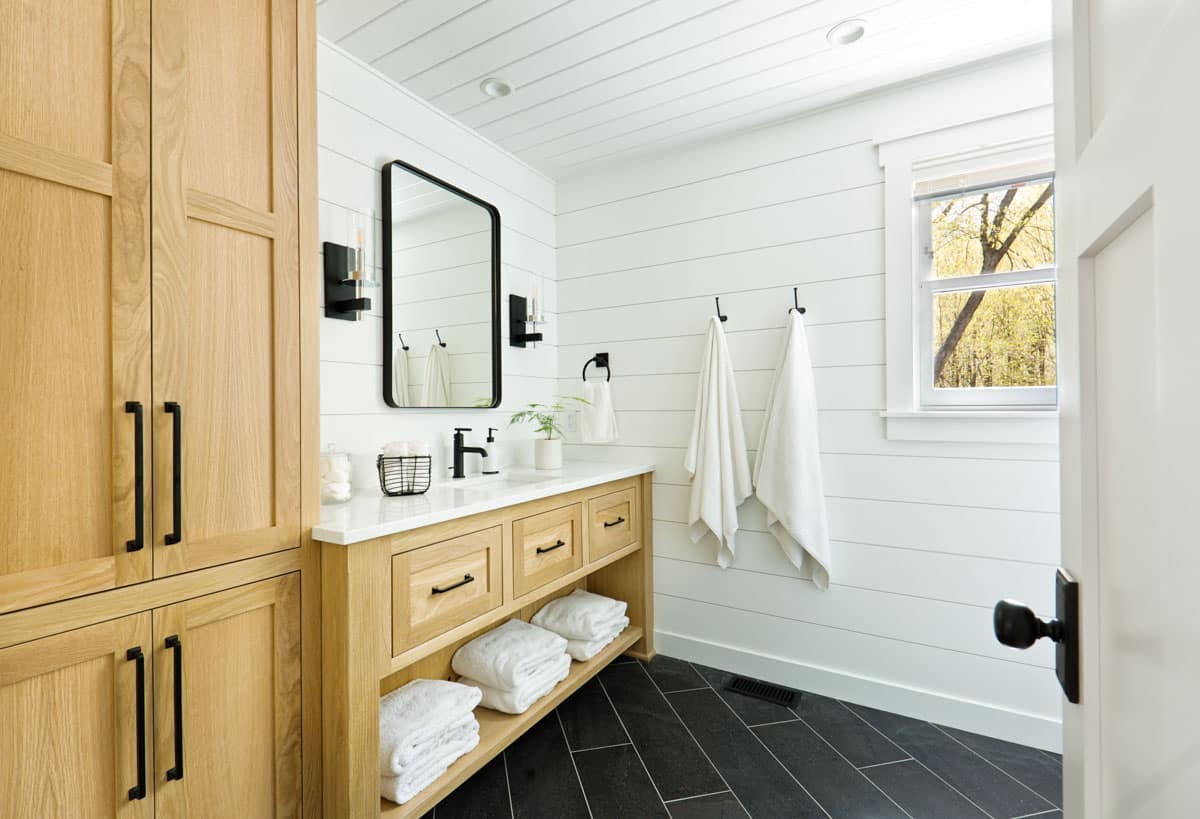
Consider Doing It Yourself: Skill and labor costs take around 25 to almost half of the installation cost. Moreover, certified tradesmen and professionals charge per hour, so it can significantly dent a huge chunk of your budget.
Carpentry work and other tasks like replacing the sink that doesn’t require licensed or certified professionals are great for DIY projects. Minor electrical or plumbing repairs that don’t need permits can also be done with minimal skills.
Revamp Old Furniture and Accessories: Sometimes, a few coats of paint or repairs are all the furniture needs to look brand new and updated. These items can exist in your room, so you’ll only need to purchase paint and other items needed to revamp your old furniture and accessories. Adding new hardware with matching finishes throughout can help immediately upgrade the look.
Choose Mid-range Materials and Fixtures: A good balance of cost and quality, mid-range materials and fixtures. However, you do need quality brands for your main fixtures, such as the water closet, sinks, and hardware. These brands include Grohe, Kohler Company, Toto Ltd., HCG, and Roca, and some of these brands offer mid-range products.
Retain or Minimize Rearranging Fixtures: Minimal or retaining your bathroom fixtures means you don’t have to spend on expensive plumbing costs or replacements. There’s also money and time spent on demolition and removal of existing materials.
Retain Structural Systems: Removing or rearranging a column or load-bearing wall can cost more than retaining your structural systems, as you might weaken areas in your room. You may also need to get the expert opinion of a contractor or structural engineer, which can add to your bathroom remodeling costs.
Don’t Move or Remove Your Walls: Keeping your drywall intact along with your structural system means there’s less construction. Instead, you can update the look of your bathroom with paint or wallpaper. Waterproof types of wallpaper that are made for wet areas are readily available on the market today.
Shop from Showrooms: Mid to Luxury Bathroom brands usually have their regular showroom activities, and it’s the perfect way to get quality materials. Check for online sales and announcements from these known brands, and you may get clearance sales and other discounts.
Less Tile, Less Expense: Bathrooms are not meant to be wet on every square inch, unless, of course, you’re aiming for a wet room. Strategic placement of tiles means you can place tiles in selected areas, usually in the shower area and around the vanity and its backsplash.
Don’t Move Your Plumbing: Relocating your plumbing lines can be expensive and time-consuming. If you want a new look for your bathroom, focus more on it.
Low-Cost Updates with High Impact
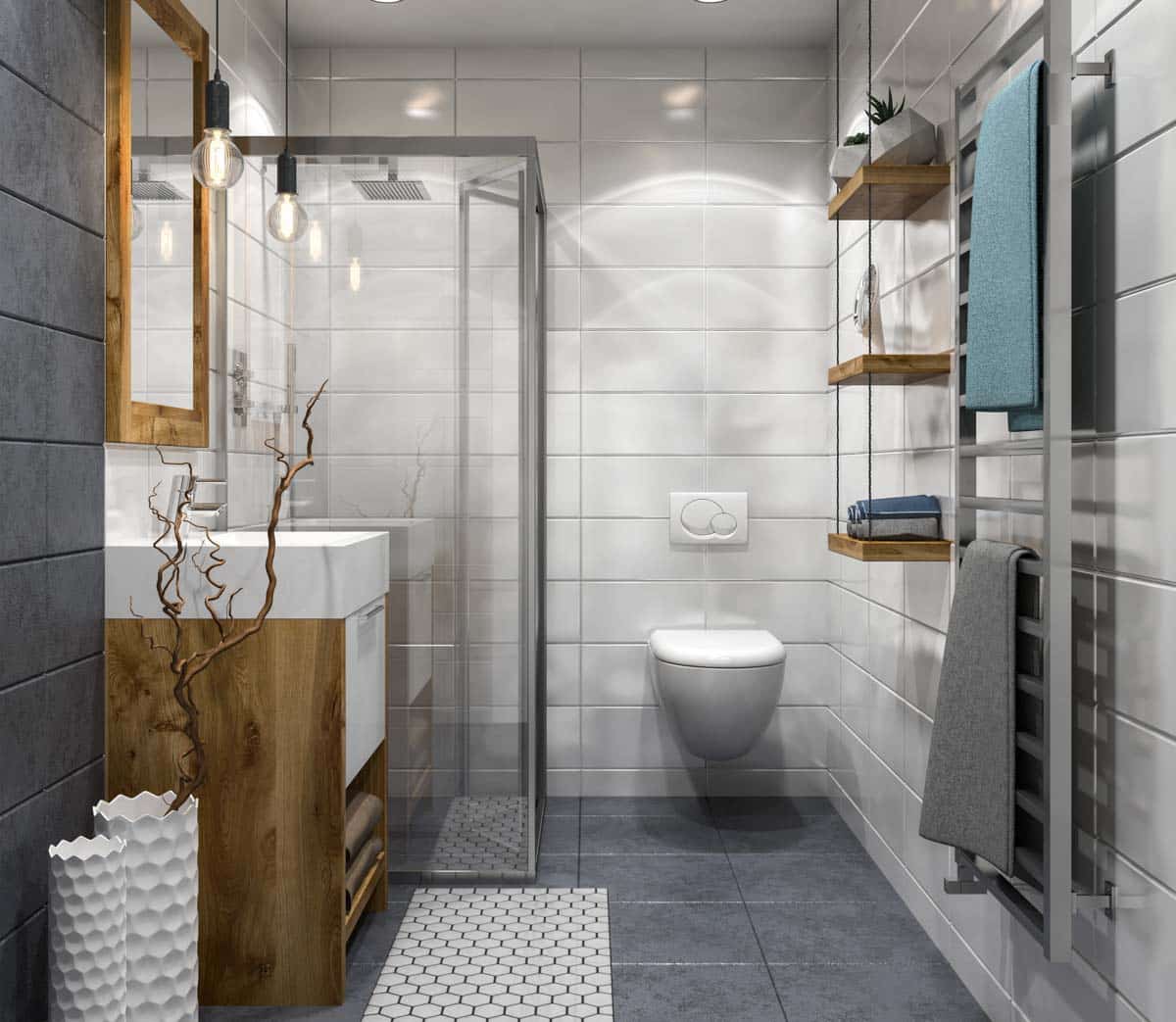
Paint: The average cost of a painting job in a bathroom is around $4 to $6, depending on the material and labor used. That’s cheaper than your tiling work of ceramic and porcelain, which can cost $5 to $17 per square foot. Tiling the shower may be a little more expensive, which can cost around $25 per square foot.
In addition to your painting costs, also consider your underlayment or substrate. Do you have a stable wall or ceiling material? Prepping up your wall will also affect the price of your remodeling. A substrate with a lot of damage can add demolition and repair costs. If you suspect you have damaged substrate, it is best to seek professional help and advice on how to resolve the damage immediately.
Hardware: Replacing your hardware fixture may not be your priority, but updating your old and worn-out hardware can breathe new life into your bathroom area without spending too much. From towel holders to cabinet hardware, there’s no shortage of elegant designs that can add a modern aesthetic to your bathroom.
The cheapest hardware material is usually made of plastic, but if you want a more durable version, hardware made from composite materials such as ABS or PVC is available. Though plastic hardware is less durable than its counterparts, it is lightweight, easy to install, and comes in a wide variety of options.
Another alternative is to find hardware finishes made of zinc and zinc alloys; these are the most affordable among the metals but, at the same time, the least durable.
When choosing hardware, prioritize quality over cost, as the bathroom is a high-traffic space where your hardware is touched and used all the time. Moreover, it’s unlikely that your expenses on your hardware pieces will significantly affect your budget.
Lighting: Allowing a good amount of natural light into your bathroom should be a priority, regardless of the size of your bathroom, as it saves on energy bills and helps keep your bathroom hygienic. LED lights are the most sensible type of lighting to install in your bathroom.
There are a plethora of LED lighting fixtures available for bathroom use that can double as decorative pieces in your space. You also have the option to highlight your open shelves or mirror area by lining it up with LED strips. This is a budget-friendly update, and you won’t need to drill or make major renovations.
By using Velcro strips to hold your LED lights, you can easily remove the strip without leaving any residue, which is a great option for renters. Utilize mirrors and other reflective surfaces to increase light.
Creative Tile Work on a Budget
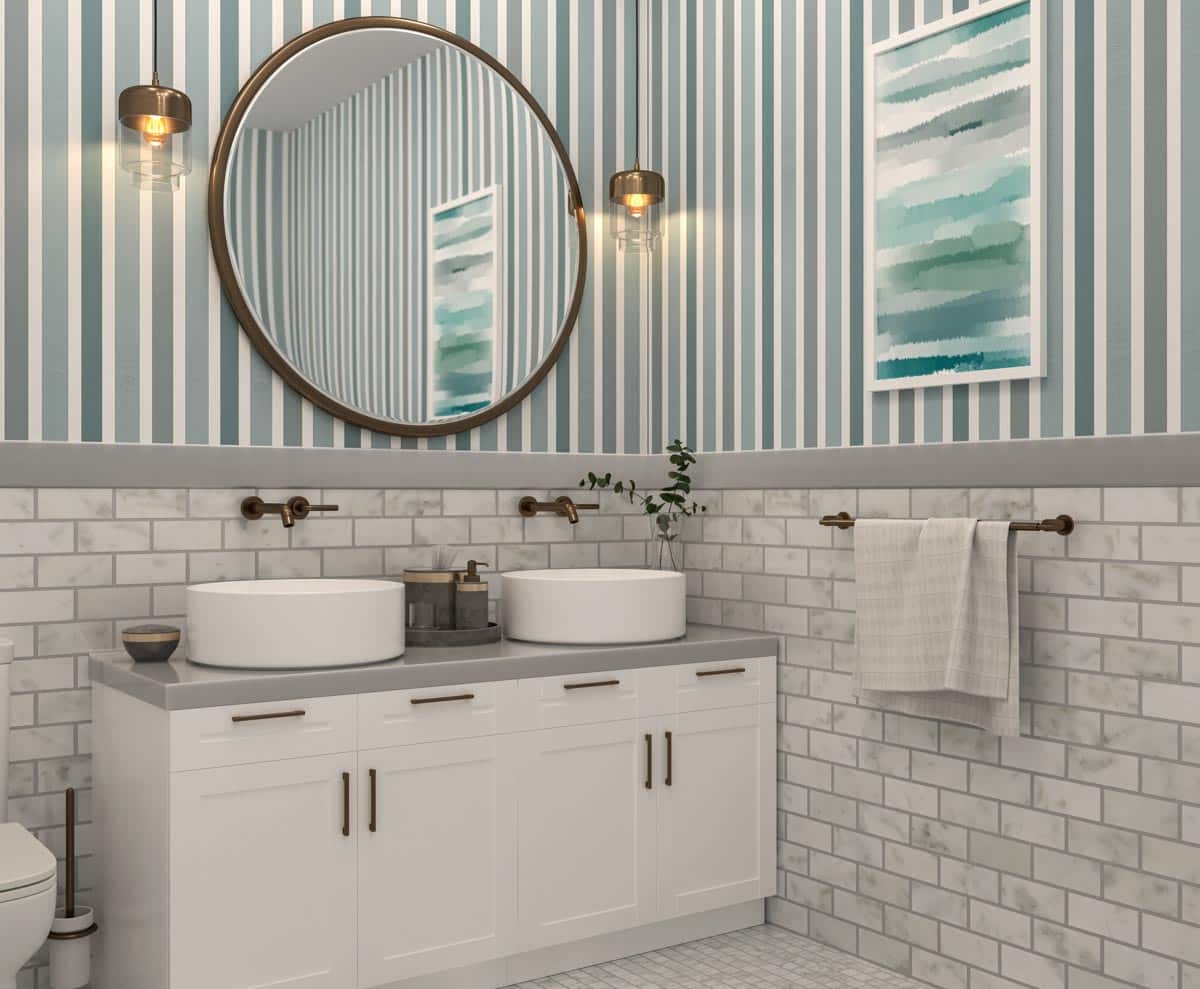
Use Vinyl Large Format Tiles: A way to create a modern and sleek-looking bathroom is to use vinyl tiles that are in large format. This is perfect for bathrooms with walls that have minimal to no damage to the substrate or wall backing, as the thin tiles will need a leveled surface to ensure longevity when installed.
Because there are fewer grout lines, it leaves a cleaner look and can create a seamless backdrop. Vinyl tiles are affordable, and there’s no shortage of designs to choose from.
Water-Resistant Peel and Stick Tiles: When you want to widen visually widen your small shower, you can add a monochromatic or striped wall with water-resistant peel-and-stick tiles. There are a lot of designs to choose from, and renters and temporary homeowners can update their bathroom area with little investment.
Peel and stick tiles can mimic any pattern and material. A brick-like façade can be installed quickly without major construction work with peel-and-stick panels.
Wallpaper that’s Water Resistant: If you’re looking for a unique look for your bathroom on your next update, consider water-resistant wallpaper. Like vinyl tiles today, there are wallpaper that have texture. The tactile finish can be combined with sleek surfaces and is easy to install. You can also opt for organic or vintage prints, as these patterns can elevate small bathroom sizes effortlessly.
White Shades are More Affordable: According to Jennifer Ott, an architectural color specialist, most affordable tiles come in white or white shades. However, with minimal expense, you can always opt for a burst of color in some areas of your bathroom. If you love tiled surfaces but want to keep your remodel costs low, choose ceramic tiles, as these versatile tiles only cost around 1 to 3 dollars per square foot.
Go Vertical with Your Layout: While the simpler the profile, the less expensive, vertical patterns for tiles give a fresh and interesting look to your bathroom, even for common tiles. You can stack up vertically oriented tiles with an alternate number of squares to give a modern and clean look to a whitewashed wall. If you want a clean cut with your tiles, you can always use a craft knife.
Maximizing Space Without Major Renovations
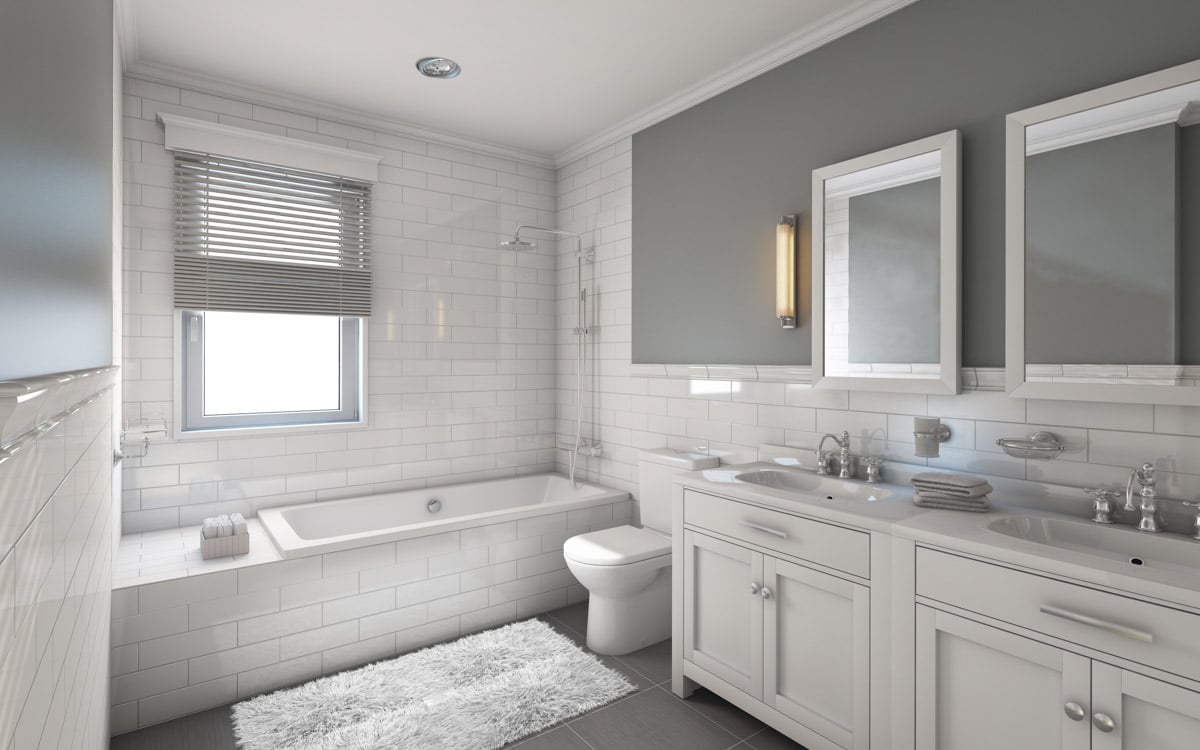
Every year, construction material costs go up, and if you’re keeping within a budget but want to utilize the space that you have, there are ways to maximize your space without major renovations:
• Use a trolley as extra furniture on wheels that can house smaller items that can be tucked away in a corner or on the side of your vanity. A multi-tired trolley with a vertical and slim profile is effective and can be moved anywhere you are when needed. You can use vintage wine racks as a trolley or a wall rack for your toiletries.
• Utilize the back of your door as an extra place to store items. You can hang multi-tier pockets to hold towels, tissue paper, and other toiletries.
• When repainting, choose neutral tones and reflective surfaces to create an airy feel in your bathroom. However, you can use deeper and brighter colors for focal points. There are darker colors that add depth to a space and are ready-made as bathroom paint.
• Use wireframe wall shelves. Wall storage with a slim and sleek profile and a wireframe structure prevents dark pockets in your bathroom space as light easily passes through items. Aside from having less visual weight, wireframe wall shelves are easier to maintain compared to the enclosed version.
• Seek professional advice. Simple renovations don’t always require an expert, but having the advice of a professional can help you reduce major renovations.
Bathroom remodels are similar to kitchen remodels, except for fixtures. Bathroom remodels may require the replacement or installation of a new bathtub, shower, or other bathing device. – The Home Owner’s Manual Operating Instructions, Troubleshooting Tips, and Advice on System Maintenance, Dan Ramsey, The Fix-It Club
• Remove the tub. If you’re not much into taking baths, you can remove your tub and expand your shower area instead. It maximizes your space according to your lifestyle and needs.
• Reuse baskets as hampers that can be easily stacked together or placed under your vanity.
Affordable Flooring Options
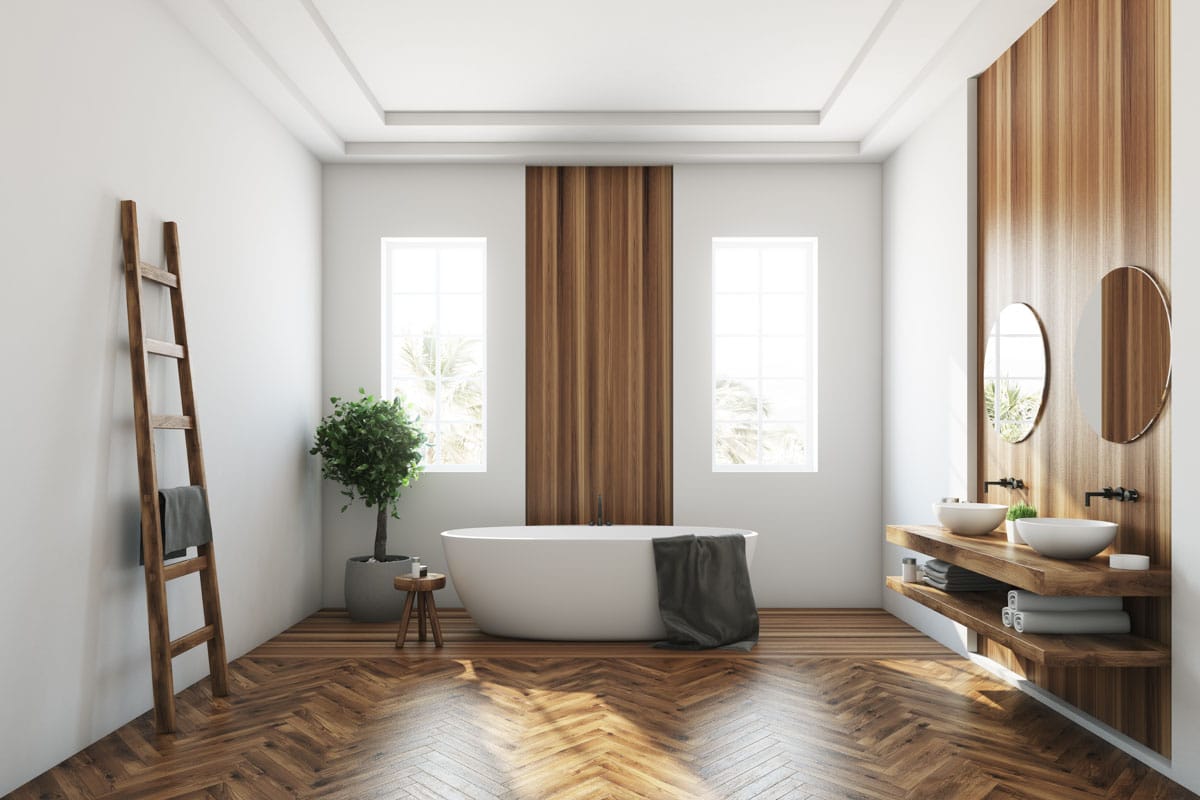
Engineered Vinyl Planks: Choose engineered vinyl planks that have WPC, or wood-plastic composite. Not only is WPC waterproof, but it is also comfortable under barefoot. Vinyl planks can cost around $3 to $11 per square foot, while sheet vinyl can cost around $2.50 to $8.50 per square foot.
Porcelain that Mimics Wood or Stone: A sensible alternative to your natural materials that is at the same time waterproof, and durable is porcelain tile. There’s a wide cost range for porcelain, so you can choose the best type of porcelain tile that fits your budget. Typically, porcelain can cost as little as $2 per square foot and as much as $30 per square foot. More expensive tiles are usually in large format.
Peel and Stick Vinyl Sheet Flooring: Unlike your old vinyl tiles, the newer versions today are better in quality, and you’ll also find a water-resistant version. Peel-and-stick vinyl tiles have a self-adhesive backing, which is revealed when you peel off the back covering.
Longer vinyl tiles can be trickier to install compared to their squarish counterparts. A square foot of peel-and-stick vinyl can cost from $2 to $7.
Concrete Flooring: Liquid stone is an affordable and versatile bathroom flooring option, and while a bare concrete floor is an attractive option, you can also use concrete paint to add color to your flooring.
Upcycling and DIY Decor
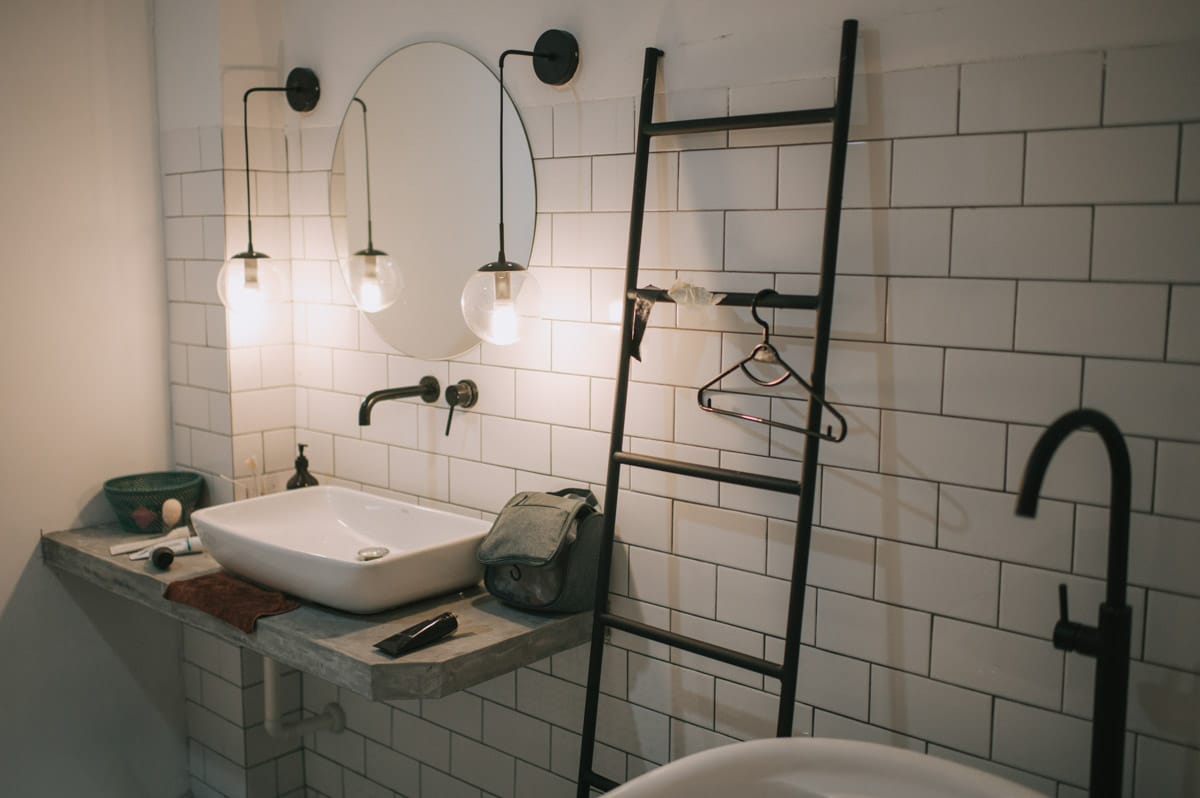
Upcycle Furniture for Storage: With a few replacement hinges, doorknobs, or pulls, a fresh coat of paint can transform an old piece of furniture into a contemporary piece. Choose waterproof paint and add varnish to wood furniture for added protection.
Repurpose Your Old Railing or Pipes: Customize a towel rack with old pipes or stairway railings. You can remove any rust and protect the surface with metal oxide to prevent further damage, then, repaint with oil-based paint to maintain a waterproof surface.
Floating Shelves Made from Old Planks: Wood from old planks or shipping crates is the perfect source for open-shelf materials. Also, you can use clear acrylic sheets cut 4 to 6 inches wide as a tier to be installed as an open shelf. Clear acrylic braces and brackets are also available to maintain that airy and clean look.
Use Leftover Tile Pieces for Décor or Furniture: Upcycle a furniture piece and finish it with your leftover tile pieces. You can also use broken tiles to create a tile mosaic to create pots and storage bins or add a mosaic wall tile to your vanity space.
Create your Own Artwork: You don’t need to purchase expensive art to add to your space. Needle artwork framed dried leaves, or flowers, there are a ton of artwork ideas you can add to your bathroom wall.
Eco-Friendly and Sustainable Choices
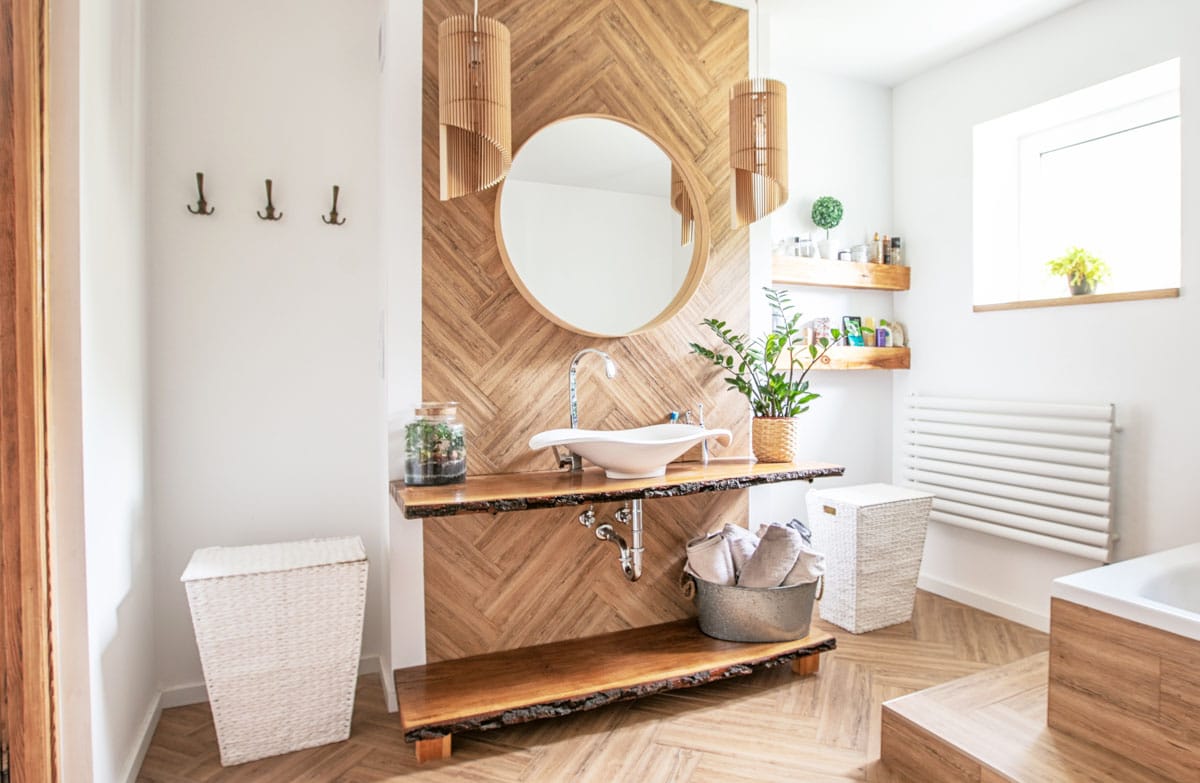
Choose biodegradable packaging: A significant amount of packaging is from soap and shampoo, especially for sachets and other smaller packs. Select biodegradable packaging, as it is easier to dispose of. Most handmade or small distributors of soap and shampoo products choose Kraft paper and other biodegradable packaging. Also, choose refillable bottles for lotions, shampoos, and other liquid products.
Use natural cleaning products: Cleaning agents that are heavily laced with chemicals not only produce harmful fumes or chemicals into the water and air but can also damage your wall, ceiling, or floor surfaces over time. Many handmade soaps and shampoos offer a variant of organic products.
Select materials that are eco-friendly: Consider materials that have been produced responsibly and that produce fewer VOCs or volatile organic compounds. Since bathrooms receive many temperature changes and dampness throughout their constant use, this environmental condition can break down liquid applications such as paint and adhesives.
These melted or evaporated chemicals can be harmful to users and can cause serious health problems when exposed over time. If low- or no-VOC paints are available, you can check the label or the Material Safety Data Sheet to check their VOC value.
See more related content in our article about the best bathroom remodel software on this page.

